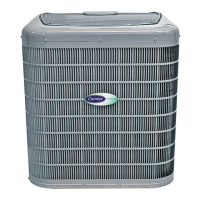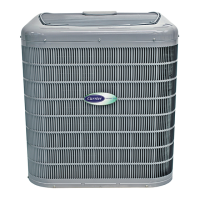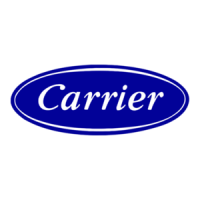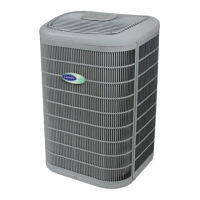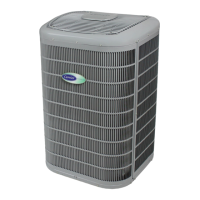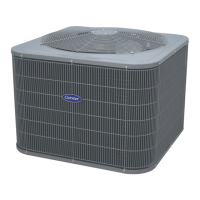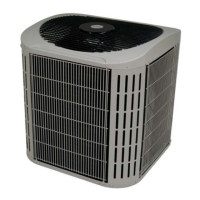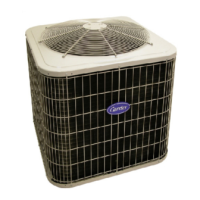10
Step 11 — System Functions and Sequence of
Operation
The 25VNA8 mod els u tilize either Infinity Touch Communicating
User Interface (UI) or conventional HP thermostat. When using UI
controls, a call for cooling will energize the outdoor fan and
compressor to run at lowest cooling demand. If this does not satisfy
cooling demand, the system will ramp up in stages until it satisfies
the demand. After coping with the higher demand, the unit returns
to lower capacity operation until the demand is satisfied or until an
increase in demand. When using a conventional thermostat, the
thermostat controls the staging of outdoor unit.
When all demand is satisfied, the compressor will shut off. As the
unit operates at lower capacity, system vapor (suction) pressure will
be higher than it is during a standard single--stage system operation
or during a higher capacity operation.
The user interface (UI) displays the operation mode and fault codes
as specified in the troubleshooting section. See Table 7 for codes
and definitions.
The conventional thermostat inputs are designed to work with most
indoor units. See AHRI for approved combinations. Connections
are Y/Y2, Y1, O, R, W, and C. Depending on thermostat and
indoor unit, the system will operate at 1 or 2 capacities in heating
or cooling mode.
NOTE: Only one code will be displayed on the outdoor unit
control board (the most recent, with the highest priority). The
latest codes are stored and can be accessed via the UI.
Upon a call for cooling through the UI (or the Y1 and/or Y2
connections in a non --communicating system), the Application
Operation Control (AOC) board (see Fig. 34) will open the EXV to
the fully open position. For heating, the AOC board will open the
EXV to a preset position, depending upon the conditions. Based
upon the indoor space demand and the outdoor conditions, the UI
will then request a compressor speed and outdoor fan motor speed.
If the conditions are correct for operation, the control board will
allow the requested operation to begin, but if the control board
determines that the conditions are not correct, the board will decide
what other operation nearing that condition is acceptable. The
inverter Motor Operational Control (MOC) then outputs the
three--phase PWM signal and frequency that gently ramps the
compressor speed up to stage 2, and then will adjust to the
demanded speed. The gentle ramp --up results in no locked rotor
amps to the compressor motor. The unit 0 for compressor LRA will
be stamped N/A (not applicable).
During operation, the AOC monitors itself and the compressor
operation along with the system pressures and temperatures. The
MOC board monitors the temperature, current and operational
status of the compressor, OD fan and the inverter itself. During
operation, the compressor speed will be adjusted to meet the
changes to the demand.
When the demand is satisfied, the inverter will ramp--down the
compressor speed and stop. The EXV will step down to the
completely closed position.
When the compressor stops, a 3.5 minute Time Guard period is
activated which is followed by opening of the PEV valve for 150
seconds to equalize the refrigerant pressure difference between the
high and low sides of the compressor. Upon equalizing the
refrigerant pressure, and an additional 15 seconds of the Time
Guard period, the compressor will be ready for the next operational
demand.
If there is a power cycle, the Pressure Equalizer Valve (PEV) will
open for 150 seconds before the compressor start--up. Opening the
PEV valve returns the discharge gas directly back to the suction
side of the compressor. This is done in either cooling or heating
mode so that the rotary compressor will start with a very low
pressure differential.
The 3.5 minute Time Guard can be bypassed by momentarily
shorting the Forced Defrost pins. Only the 3.5 minute time delay
can be bypassed. Because it is important for compressor reliability,
the 150--second PEV delay cannot be bypassed.
Crankcase Heater Operation
This unit has an internal crankcase heater that will be energized
during the of f cycle and is intelligently demanded by the system to
prevent the compressor from being the coldest part of the system
thus enhancing the reliability. The crankcase heater will function
as needed any time the outdoor unit is powered. The indoor unit
and UI do not need to be installed for the crankcase heater to
operate properly.
The compressor windings will occasionally be energized during
the OFF cycle (depending on the length of the OFF cycle) to start
the stator heat operation, thus maintaining a sump temperature that
is essential for compressor reliability. The compressor will not run
during this process.
Outdoor Fan Motor Operation
The outdoor unit control (Fig. 16) energizes outdoor fan anytime
the compressor is operating, except for defrost. The OD fan motor
is variable speed. The speed will change depending on the ambient
temperature and the cooling or heating capacity required.
Time Delays
The unit time delays include:
S 3.5 minute time delay after last cycle, initial power up, return
from brown-- out condition. To bypass this feature, momentarily
short and release Forced Defrost pins.
S At the end of every compressor ON cycle, there will be 150
seconds of PEV open period for pressure equalization followed
by 15 seconds of PEV Off period before the next compressor
ON cycle. This delay cannot be bypassed as it helps compressor
reliability.
S 15 second delay at termination of defrost before the auxiliary
heat is de--energized.
S See Table 7 for other delay information.
Communication and Status Function Lights
Infinity Touch Control, Green Communications
(COMM)Light
A green LED (COMM light) on the outdoor board (see Fig. 16)
indicates successful communication with the other system
products. The green LED will remain OFF until communication is
established. Once a valid command is received, the green LED will
turn ON continuously. If no communication is received within 2
minutes, the LED will be turned OFF until the next valid
communication. The green LED will be turned off when using a
standard 2 -- stage non--communicating heat pump thermostat.
Amber Status Light
Amber colored STATUS light indicates operation and error status.
See Table 7 for definitions.
S Two minute time delay to return to standby operation from last
valid communication.
Defr ost
This user interface (UI) offers 5 possible defrost interval times: 30,
60 and 90 minutes, or AUTO. The default is AUTO.
Defrost interval times: 30, 60, and 90 minutes or AUTO are
selected by the Infinity Touch Control User Interface if using UI.
The 90 and 120 minute selection will default to 60 minutes at
ambient below 37 degrees. The 120 minute selection will default
to 90 minutes at ambient above 37 degrees.
If using non--communicating thermostat, defrost intervals are set
using dip switches on outdoor control board (see Fig. 16). AUTO
defrosts adjusts the defrost interval time based on the last defrost
time as follows:
S When defrost time <5 minutes, the next defrost interval=90
minutes. (outdoor temperature above 37_F)
S When defrost time 5 -- 7 minutes, the next defrost interval=60
minutes.
S When defrost time >7 minutes, the next defrost interval=30
minutes.
Manufacturer reserves the right to change, at any time, specifications and designs without notice and without obligations .
Catalog No: 25
N
8 --- 5 S I
Replaces: 25VNA8---4SI
